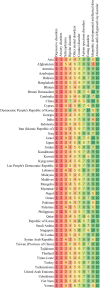The burden of mental disorders in Asian countries, 1990-2019: an analysis for the global burden of disease study 2019
- PMID: 38548717
- PMCID: PMC10978857
- DOI: 10.1038/s41398-024-02864-5
The burden of mental disorders in Asian countries, 1990-2019: an analysis for the global burden of disease study 2019
Abstract
Mental disorders are the leading contributors to the globally nonfatal burden of disease. This study was aimed to estimate the burden of mental disorders in Asian countries. Based on GBD 2019, the prevalence and disability-adjusted life of years (DALYs) rates with 95% uncertainty intervals (UI) were estimated in Asian countries. Predictions for the future burden of 8 selected countries, ranks of the burden of mental disorders and correlations with Sociodemographic Index (SDI) were also estimated. During the past 3 decades, while the number of DALYs of mental disorders increased from 43.9 million (95% UI: 32.5-57.2) to 69.0 million (95% UI: 51.0-89.7), the age-standardized rates of DALYs of mental disorders remained largely consistent from 1452.2 (95% UI: 1080.16-1888.53) per 100,000 population in 1990 to 1434.82 (95% UI: 1065.02-1867.27) per 100,000 population in 2019, ranked as the eighth most significant disease burden in Asia in 2019. Depressive disorders (37.2%) were the leading contributors to the age-standardized DALY rates of mental disorders in Asia, followed by anxiety disorders (21.5%). The age-standardized DALY rates in females were higher than their male counterparts, both peaked at 30-34 years. The age-standardized DALY rates were predicted to remain stable, with the number of DALYs presented an upward trend in the future. There was no significant correlation between the burden of mental disorders and SDI. All mental disorders ranked higher in 2019, compared in 1990. To reduce this burden, urgent measures for prevention, treatment, and rehabilitation for mental disorders need to be taken by Asian governments.
© 2024. The Author(s).
Conflict of interest statement
Q.C., S.H., H.X., J.P., P.W., S.L., J.Z., X.S., W.Z., L.S., Y.P., and X.T. all have no conflicts of interest or financial ties to disclose.
Figures











References
MeSH terms
LinkOut - more resources
Full Text Sources
Medical
Miscellaneous

